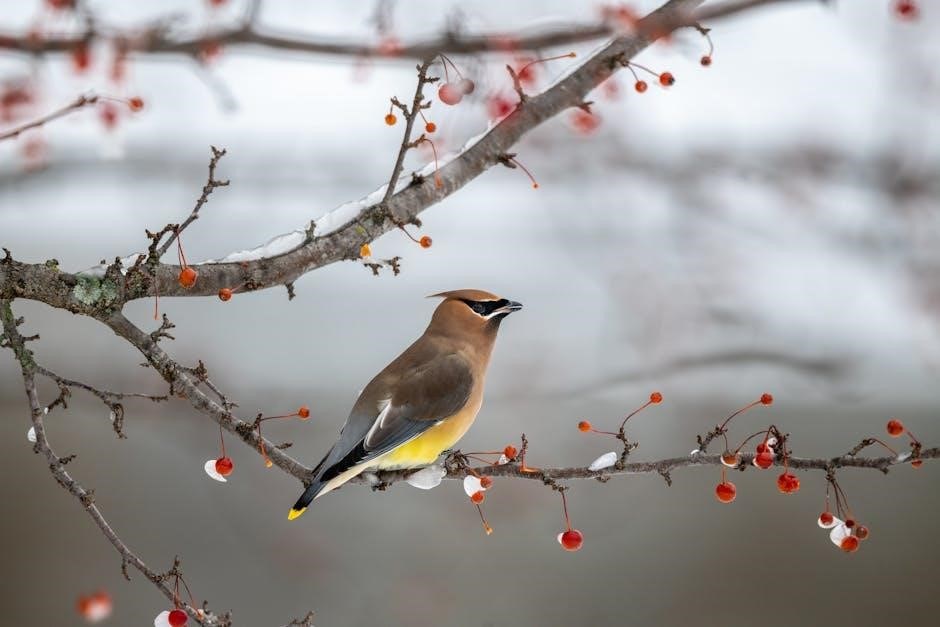Wendell Berry’s work explores human relationship with nature through poetry and prose, using simple language to convey complex themes and ideas about life and environment always.
Overview of Wendell Berry’s Life and Career
Wendell Berry is a renowned American poet, novelist, and environmentalist, born in 1934, with a career spanning over six decades, during which he has published more than 40 books, including novels, short stories, and poetry collections. His work is characterized by a strong sense of place and a deep connection to the natural world, which is reflected in his writing style and themes. Berry’s life and career have been marked by a commitment to simplicity, sustainability, and social justice, which are evident in his writing and public speaking. He has received numerous awards and honors for his work, including the National Humanities Medal and the Pulitzer Prize. Berry’s writing has been widely acclaimed for its beauty, wisdom, and insight into the human condition, and he continues to be a prominent voice in American literature and environmentalism, with a unique perspective on the world.

The Peace of Wild Things Poem
Wendell Berry’s poem is a beautiful and thought-provoking work of literature that explores human relationship with nature always.
The poem explores the idea of finding peace in nature, with the speaker describing how they come into the peace of wild things who do not tax their lives with forethought of grief. The poem is a reflection on the human condition, with the speaker seeking solace in the natural world. The use of imagery and metaphor adds depth and complexity to the poem, with the wood drake and great heron serving as symbols of peace and tranquility. The poem’s themes of nature, peace, and the human condition are intertwined, creating a rich and thought-provoking work of literature. The speaker’s journey into the peace of wild things is a powerful exploration of the human experience, and the poem’s message continues to resonate with readers today, offering a unique perspective on the world and our place in it always and forever.
Themes and Symbolism in the Poem
The poem explores several themes, including the human relationship with nature, the search for peace and tranquility, and the importance of living in the present moment. The wood drake and great heron are symbolic of peace and freedom, while the still water represents calmness and serenity. The day-blind stars waiting with their light symbolize hope and guidance. The poem’s themes are intertwined with its symbolism, creating a rich and complex work of literature. The use of natural imagery and symbolism adds depth and meaning to the poem, inviting the reader to reflect on their own relationship with nature and the world around them. The poem’s themes and symbolism work together to create a powerful and thought-provoking work of literature that continues to resonate with readers today, offering a unique perspective on the human experience and our place in the world.

Wendell Berry’s Environmentalism and Poetry
Wendell Berry’s poetry combines environmentalism and social commentary, using nature as a backdrop to explore human relationships always;
Connection between Nature and Human Experience
Wendell Berry’s work often explores the connection between nature and human experience, using imagery and metaphor to convey the idea that humans are a part of the natural world. The poem “The Peace of Wild Things” is a prime example of this, as it describes the speaker’s journey into the natural world to find peace and solace. Through the use of natural imagery, Berry creates a sense of calm and tranquility, highlighting the importance of nature in human life. The poem also touches on the idea that humans can learn from nature, and that the natural world has the power to heal and transform us. By exploring the connection between nature and human experience, Berry’s work encourages readers to rethink their relationship with the environment and to consider the impact of their actions on the world around them. This connection is a central theme in Berry’s work.
Importance of Conservation and Sustainability
Wendell Berry’s work emphasizes the importance of conservation and sustainability, encouraging readers to adopt a more environmentally conscious lifestyle. Through his poetry and prose, Berry highlights the interconnectedness of human and natural systems, emphasizing the need to preserve and protect the natural world. The poem “The Peace of Wild Things” suggests that humans can find peace and solace in nature, but also implies that this peace is fragile and requires effort to maintain. Berry’s work encourages readers to consider the long-term consequences of their actions and to prioritize sustainability and conservation. By promoting a deeper understanding of the natural world and our place within it, Berry’s work inspires readers to take action to protect the environment and ensure a more sustainable future for all, using simple yet effective language to convey this important message and inspire change. This is a key aspect of his work.

Analysis of the Poem’s Structure and Style
Wendell Berry’s poem features a simple and reflective structure, with a focus on natural imagery and symbolism, using language to convey a sense of peace always effectively.
Use of Imagery and Metaphor in the Poem
The poem employs vivid imagery to convey a sense of peace and tranquility, with descriptions of natural scenes, such as the wood drake and great heron, creating a soothing atmosphere. The use of metaphor, as seen in the comparison of the speaker’s life to the peaceful existence of wild things, adds depth and complexity to the poem. The imagery and metaphor work together to create a sense of longing for a simpler, more peaceful way of life, and to highlight the importance of finding solace in nature. The poem’s use of imagery and metaphor is characteristic of Wendell Berry’s style, which often explores the human relationship with the natural world. The effective use of these literary devices helps to convey the poem’s themes and ideas, making it a powerful and thought-provoking work. The poem’s imagery and metaphor are central to its meaning and impact.
Wendell Berry’s Unique Writing Style
Wendell Berry’s writing style is characterized by its simplicity, clarity, and depth, making his work accessible to a wide range of readers. His use of language is often described as lyrical and poetic, even in his prose works. The style is also notable for its emphasis on the importance of place and community, reflecting Berry’s own experiences as a farmer and resident of rural Kentucky. The writing style is deeply rooted in the natural world, and Berry’s love of nature and his concern for its preservation are evident throughout his work. The unique style has been praised for its ability to convey complex ideas and emotions in a simple and direct way, making Berry one of the most respected and beloved writers of his generation. His style continues to inspire and influence writers and readers alike.

Reception and Impact of the Poem
The poem received widespread acclaim for its beautiful language and universal themes always touching readers.
Reviews and Criticisms of the Poem
Reviews of the poem have been overwhelmingly positive, with many critics praising its lyrical language and universal themes. The poem’s ability to evoke a sense of peace and tranquility in the reader has been particularly noted. Some critics have also praised the poem’s use of imagery and symbolism, which adds depth and complexity to the poem’s themes. However, some critics have also noted that the poem’s message may be seen as too simplistic or escapist, and that it does not provide a clear solution to the problems it addresses. Despite these criticisms, the poem remains widely admired and studied, and its exploration of the human relationship with nature continues to resonate with readers. The poem’s impact on modern poetry and environmentalism is also significant, and it continues to be widely read and appreciated today.
Influence of the Poem on Modern Poetry and Environmentalism
The poem’s influence on modern poetry and environmentalism is significant, with many poets and writers citing Wendell Berry as an inspiration. The poem’s themes of nature and conservation have resonated with readers and encouraged a new generation of writers to explore these topics. The poem’s use of simple and accessible language has also made it a model for poets looking to write about complex issues in a clear and concise way. Additionally, the poem’s exploration of the human relationship with the natural world has influenced the development of ecopoetry and environmental literature. The poem’s impact can be seen in the work of many contemporary poets and writers, and it continues to be widely studied and admired today. The poem’s influence extends beyond literature, inspiring environmentalists and conservationists to take action to protect the natural world.
